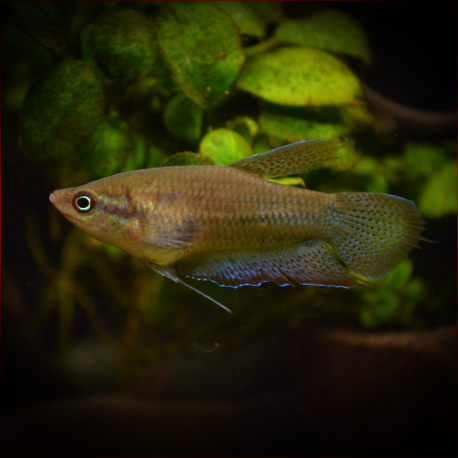More info
Datasheet
| Minimum Tank Size | 60 litres / 15.85 US gallons |
| Maximum Size | 7.0cm / 2.76inches |
| Temperature | 22°C / 71.60°F - 28°C / 82.40°F |
| Hardness | 1.01dgH / 18ppm - 15.02dgH / 268ppm |
| pH | 5.0-7.5 |
General Description
Trichopsis vittata, commonly known as the Croaking Gourami, is distinguished by its larger size among congeners and unique anal-fin rays that extend almost to the tip of the caudal-fin. They are known for producing audible sounds using a specialized pectoral mechanism. Possessing an accessory breathing organ known as the labyrinth, they have evolved to breathe atmospheric air to a certain extent.
Aquarium Setup
The ideal aquarium setup for Trichopsis vittata includes well-planted vegetation, surface cover like tall stem plants and floating varieties, and driftwood for shelter. Dried leaf litter can be added to provide cover, food sources for fry, and release beneficial chemicals as it decomposes. It is crucial to maintain access to a layer of warm, humid air above the water surface for optimal breeding conditions.
Behaviour
Croaking Gouramis are peaceful except during breeding times, displaying unique behavioral interactions in groups. They are known to settle conflicts using factors such as body weight and length, transmitted through visual and acoustic signals. During courtship, the female initiates spawning by producing 'purring' sounds, a behavior specific to this species.
Feeding and Diet
In the wild, Trichopsis vittata preys on aquatic and terrestrial invertebrates. In captivity, they readily accept dried foods but should be provided with small live or frozen options such as Daphnia, Artemia, or bloodworms to maintain optimal coloration and health.
Reproduction & Dimorphism
These bubble nesters prefer soft water with slightly elevated temperatures for breeding. Males are larger and possess extended fins, and during spawning, the male collects and transports eggs to the nest. After hatching, fry require special food like infusoria before transitioning to motile foods such as microworms and Artemia nauplii.
Habitat and Distribution
Trichopsis vittata is found in still to slow-moving waters with dense aquatic vegetation in Indochina, including the Mekong River basin, southern Thailand, and parts of Malaysia. Feral populations exist in countries like the Philippines, India, and the U.S.A., with the species' type locality in Java, Indonesia.

